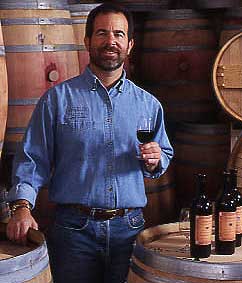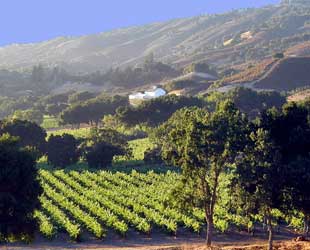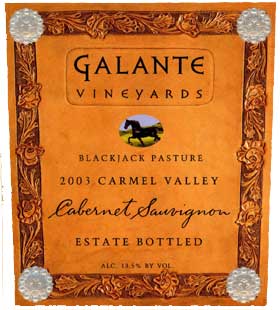

Jack Galante talks about the pros and cons of his truly diverse AVA.
Diversity Training: Growing Various Varietals in a Climate-Varying Valley
We have a wonderful diversity of grapes that we grow on our 700-acre ranch. This is mainly due to the diversity in terroir, or micro-geographic locations, on our property. Our ranch rises from 700 feet above sea level to 2,200 feet.
~Jack Galante
by
Laurie Daniel
January 26, 2007
Laurie Daniel (LD): What makes Carmel Valley different from other viticultural areas in Monterey?
Jack Galante (JG): Geographically, the Carmel Valley appellation is very different from the rest of Monterey County. Most of the appellation is nestled in an inland valley situated approximately 15 miles from the Monterey Bay and 10 miles from Big Sur, as the crow flies. However, travel time to the center of the appellation in the Cachagua Valley takes approximately 45 minutes from Monterey, and rugged terrain separates the Cachagua Valley from the coast. The appellation is also marked with extreme physical differences. There is a considerable change in altitude in the area, from a few hundred feet to above 2,200 feet.
physical differences. There is a considerable change in altitude in the area, from a few hundred feet to above 2,200 feet.
As such, the climatic variations are also quite extreme. In the heart of the appellation, temperatures in the growing season vary from the mid-30s or 40s at night to over 100 degrees in the day. This leads to a long growing season, with harvest normally occurring from late October to mid-November. This long "hang time" causes the grapes to ripen slowly, intensifying their rich berry flavors. The region is not marked with much fog, unlike much of Monterey County; the days and nights are normally dry. For the most part, vineyards are situated on hillsides, and the soils range from highly drained, river-rock studded loam and sandstone to decomposed granite at the higher elevations.
LD: You grow grapes as diverse as Cabernet Sauvignon, Petite Sirah and Pinot Noir at Galante. How are you able to do that? Is that diversity common elsewhere in the Carmel Valley AVA?
JG: Yes, we have a wonderful diversity of grapes that we grow on our 700-acre ranch. This is mainly due to the diversity in terroir, or micro-geographic locations, on our property. Our ranch rises from 700 feet above sea level to 2,200 feet. Since cooler air concentrates in the valley, we grow certain varieties which bud later and have shorter growing cycles, such as Cabernet Sauvignon, at the lower elevations and Pinot Noir, which buds earlier, at 1,000 feet higher in the hills to avoid freezing and damaging the sensitive buds.
Of course, we also have to match soil compatibility in choosing our rootstocks and varietals, but climate is the driving factor. Through experimentation, we have found that some varieties do well at multiple elevations, although the flavor characteristics vary considerably. There are certainly several wineries in the appellation which successfully grow multiple varietals, but I am unaware of other vineyards that enjoy the range of diversity that we have on our property.
LD: Which grape variety do you think is most successful in the AVA?
JG: If you asked me this 10 years ago, I would unquestionably say Cabernet Sauvignon. Although Cabernet is still the king in our appellation, we have seen changes in our climate over the last 10 years that have proven very favorable to varieties such as Petite Sirah, Sauvignon Blanc and Pinot Noir. We are especially pleased with our accomplishments with Petite Sirah, and we look forward to great advancements from this varietal in the years to come.
LD: Can you elaborate on those changes and how they were favorable to those grapes in particular? It seems a little counter-intuitive: I would think it would be good for Sauvignon Blanc and Pinot Noir if the climate got cooler, but better for Petite Sirah if it got warmer.
JG: That would normally be true, but we have our Pinot Noir planted 1,000 feet above our Petite Sirah. These are different climatic zones on the property. It seems like the temperatures are less extreme and somewhat cooler, the higher we go up our mountain, where the Pinot is grown. Of course, there are yearly anomalies to this trend, such as this past year. Our Cabernet grapes seem to have increased in tannins, which we attribute to the climate as well as the age of the vines. We have altered some of our treatment of these grapes in the winery to counteract this, which has been very successful. Since our Petite Sirah plantings are so new, it is really hard to pinpoint the cause of their success. I probably should have left out the Sauvignon Blanc, since most of the changes there should be attributed to other factors such as newer plantings on rootstock.
LD: Back in the ‘70s, a lot of Cabernet Sauvignon was planted in areas of Monterey which were too cool to ripen Cabernet. Consequently, many consumers still think Monterey Cabernet is vegetal. But Cabernet is grown successfully in Carmel Valley. How have vintners in Carmel Valley dealt with the old reputation?
JG: Carmel Valley never had the reputation of growing Cabernet with vegetal characteristics. When Monterey County got this reputation, there was only one Carmel Valley vineyard in existence. Most Cabernet was grown in other, cooler areas of Monterey County with significantly different terroirs and climates. The only vineyard that grew Cabernet in our appellation was Durney Vineyards, which was founded in 1969, and the early Cabernets that came out of that vineyard were anything but vegetal. The other Carmel Valley vineyards, including ours, started planting in the early 1980s.
Cabernet in our appellation was Durney Vineyards, which was founded in 1969, and the early Cabernets that came out of that vineyard were anything but vegetal. The other Carmel Valley vineyards, including ours, started planting in the early 1980s.
Many of the early Cabernets which came out of the lower regions of Monterey County did have vegetal characteristics. However, with the tremendous advances in viticultural practices which have taken place over the last 30 years, these traits have been all but been eradicated from those Monterey County vineyards which still grow Cabernet. Unfortunately, reputations, like bad habits, don’t die easily, and we are still faced with people who have heard somewhere that Monterey County Cabernets have vegetal traits, and since Carmel Valley is part of Monterey, they assume that these flavors exist even before trying the wines. Even many wine-educated people, including writers, restaurateurs and retailers, bring up this reputation, and they seem surprised after they taste our Cabernets, which don’t have any vegetal characteristics. It is a continuing educational process.
LD: Are the boundaries of the AVA appropriate, or should they be revised?
JG: I believe that they are appropriate as is, but if anything is to change, the current AVA could be reduced in size and two AVAs created. There are significant climatic differences between the upper Cachagua region (where Galante is located) and the lower Carmel Valley Village area, both of which produce excellent wines.
LD: Can you elaborate on those differences?
JG: I don’t have any specific climatic data on the village area, but in general, the lows are not as low and the highs are not as high. This can make a considerable difference. You can really notice this when you crest the Cachagua grade and fall down into our valley. There is also more fog in the Carmel Valley Village than in Cachagua.
Jack Galante (JG): Geographically, the Carmel Valley appellation is very different from the rest of Monterey County. Most of the appellation is nestled in an inland valley situated approximately 15 miles from the Monterey Bay and 10 miles from Big Sur, as the crow flies. However, travel time to the center of the appellation in the Cachagua Valley takes approximately 45 minutes from Monterey, and rugged terrain separates the Cachagua Valley from the coast. The appellation is also marked with extreme
 physical differences. There is a considerable change in altitude in the area, from a few hundred feet to above 2,200 feet.
physical differences. There is a considerable change in altitude in the area, from a few hundred feet to above 2,200 feet.
As such, the climatic variations are also quite extreme. In the heart of the appellation, temperatures in the growing season vary from the mid-30s or 40s at night to over 100 degrees in the day. This leads to a long growing season, with harvest normally occurring from late October to mid-November. This long "hang time" causes the grapes to ripen slowly, intensifying their rich berry flavors. The region is not marked with much fog, unlike much of Monterey County; the days and nights are normally dry. For the most part, vineyards are situated on hillsides, and the soils range from highly drained, river-rock studded loam and sandstone to decomposed granite at the higher elevations.
LD: You grow grapes as diverse as Cabernet Sauvignon, Petite Sirah and Pinot Noir at Galante. How are you able to do that? Is that diversity common elsewhere in the Carmel Valley AVA?
JG: Yes, we have a wonderful diversity of grapes that we grow on our 700-acre ranch. This is mainly due to the diversity in terroir, or micro-geographic locations, on our property. Our ranch rises from 700 feet above sea level to 2,200 feet. Since cooler air concentrates in the valley, we grow certain varieties which bud later and have shorter growing cycles, such as Cabernet Sauvignon, at the lower elevations and Pinot Noir, which buds earlier, at 1,000 feet higher in the hills to avoid freezing and damaging the sensitive buds.
Of course, we also have to match soil compatibility in choosing our rootstocks and varietals, but climate is the driving factor. Through experimentation, we have found that some varieties do well at multiple elevations, although the flavor characteristics vary considerably. There are certainly several wineries in the appellation which successfully grow multiple varietals, but I am unaware of other vineyards that enjoy the range of diversity that we have on our property.
LD: Which grape variety do you think is most successful in the AVA?
JG: If you asked me this 10 years ago, I would unquestionably say Cabernet Sauvignon. Although Cabernet is still the king in our appellation, we have seen changes in our climate over the last 10 years that have proven very favorable to varieties such as Petite Sirah, Sauvignon Blanc and Pinot Noir. We are especially pleased with our accomplishments with Petite Sirah, and we look forward to great advancements from this varietal in the years to come.
LD: Can you elaborate on those changes and how they were favorable to those grapes in particular? It seems a little counter-intuitive: I would think it would be good for Sauvignon Blanc and Pinot Noir if the climate got cooler, but better for Petite Sirah if it got warmer.
JG: That would normally be true, but we have our Pinot Noir planted 1,000 feet above our Petite Sirah. These are different climatic zones on the property. It seems like the temperatures are less extreme and somewhat cooler, the higher we go up our mountain, where the Pinot is grown. Of course, there are yearly anomalies to this trend, such as this past year. Our Cabernet grapes seem to have increased in tannins, which we attribute to the climate as well as the age of the vines. We have altered some of our treatment of these grapes in the winery to counteract this, which has been very successful. Since our Petite Sirah plantings are so new, it is really hard to pinpoint the cause of their success. I probably should have left out the Sauvignon Blanc, since most of the changes there should be attributed to other factors such as newer plantings on rootstock.
LD: Back in the ‘70s, a lot of Cabernet Sauvignon was planted in areas of Monterey which were too cool to ripen Cabernet. Consequently, many consumers still think Monterey Cabernet is vegetal. But Cabernet is grown successfully in Carmel Valley. How have vintners in Carmel Valley dealt with the old reputation?
JG: Carmel Valley never had the reputation of growing Cabernet with vegetal characteristics. When Monterey County got this reputation, there was only one Carmel Valley vineyard in existence. Most Cabernet was grown in other, cooler areas of Monterey County with significantly different terroirs and climates. The only vineyard that grew
 Cabernet in our appellation was Durney Vineyards, which was founded in 1969, and the early Cabernets that came out of that vineyard were anything but vegetal. The other Carmel Valley vineyards, including ours, started planting in the early 1980s.
Cabernet in our appellation was Durney Vineyards, which was founded in 1969, and the early Cabernets that came out of that vineyard were anything but vegetal. The other Carmel Valley vineyards, including ours, started planting in the early 1980s.
Many of the early Cabernets which came out of the lower regions of Monterey County did have vegetal characteristics. However, with the tremendous advances in viticultural practices which have taken place over the last 30 years, these traits have been all but been eradicated from those Monterey County vineyards which still grow Cabernet. Unfortunately, reputations, like bad habits, don’t die easily, and we are still faced with people who have heard somewhere that Monterey County Cabernets have vegetal traits, and since Carmel Valley is part of Monterey, they assume that these flavors exist even before trying the wines. Even many wine-educated people, including writers, restaurateurs and retailers, bring up this reputation, and they seem surprised after they taste our Cabernets, which don’t have any vegetal characteristics. It is a continuing educational process.
LD: Are the boundaries of the AVA appropriate, or should they be revised?
JG: I believe that they are appropriate as is, but if anything is to change, the current AVA could be reduced in size and two AVAs created. There are significant climatic differences between the upper Cachagua region (where Galante is located) and the lower Carmel Valley Village area, both of which produce excellent wines.
LD: Can you elaborate on those differences?
JG: I don’t have any specific climatic data on the village area, but in general, the lows are not as low and the highs are not as high. This can make a considerable difference. You can really notice this when you crest the Cachagua grade and fall down into our valley. There is also more fog in the Carmel Valley Village than in Cachagua.
Print this article | Email this article | More about Carmel Valley | More from Laurie Daniel












